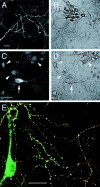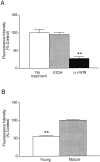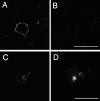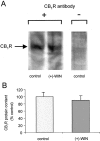Agonist-induced internalization and trafficking of cannabinoid CB1 receptors in hippocampal neurons
- PMID: 11264316
- PMCID: PMC6762401
- DOI: 10.1523/JNEUROSCI.21-07-02425.2001
Agonist-induced internalization and trafficking of cannabinoid CB1 receptors in hippocampal neurons
Abstract
Agonist-induced internalization of G-protein-coupled receptors is an important mechanism for regulating receptor abundance and availability at the plasma membrane. In this study we have used immunolabeling techniques and confocal microscopy to investigate agonist-induced internalization and trafficking of CB(1) receptors in rat cultured hippocampal neurons. The levels of cell surface CB(1) receptor immunoreactivity associated with presynaptic GABAergic terminals decreased markedly (by up to 84%) after exposure to the cannabinoid agonist (+)-WIN55212, in a concentration-dependent (0.1-1 microm) and stereoselective manner. Inhibition was maximal at 16 hr and abolished in the presence of SR141716A, a selective CB(1) receptor antagonist. Methanandamide (an analog of an endogenous cannabinoid, anandamide) also reduced cell surface labeling (by 43% at 1 microm). Differential labeling of cell surface and intracellular pools of receptor demonstrated that the reduction in cell surface immunoreactivity reflects agonist-induced internalization and suggests that the internalized CB(1) receptors are translocated toward the soma. The internalization process did not require activated G-protein alpha(i) or alpha(o) subunits. A different pattern of cell surface CB(1) receptor expression was observed using an undifferentiated F-11 cell line, which had pronounced somatic labeling. In these cells substantial CB(1) receptor internalization was also observed after exposure to (+)-WIN55212 (1 microm) for relatively short periods (30 min) of agonist exposure. In summary, this dynamic modulation of CB(1) receptor expression may play an important role in the development of cannabinoid tolerance in the CNS. Agonist-induced internalization at presynaptic terminals has important implications for the modulatory effects of G-protein-coupled receptors on neurotransmitter release.
Figures







References
-
- Bouaboula M, Perrachon S, Milligan L, Canat X, Rinaldi-Carmona M, Portier M, Barth F, Calandra B, Pecceu F, Lupker J, Maffrand J-P, Le Fur G, Casellas P. A selective inverse agonist for central cannabinoid receptor inhibits mitogen-activated protein kinase activation stimulated by insulin or insulin-like growth factor 1. Evidence for a new model of receptor/ligand interactions. J Biol Chem. 1997;272:22330–22339. - PubMed
-
- Devane WA, Hanus L, Breuer A, Pertwee RG, Stevenson LA, Griffin G, Gibson D, Mandelbaum A, Etinger A, Mechoulam R. Isolation and structure of a brain constituent that binds to the cannabinoid receptor. Science. 1992;258:1946–1949. - PubMed
Publication types
MeSH terms
Substances
Grants and funding
LinkOut - more resources
Full Text Sources
Miscellaneous
